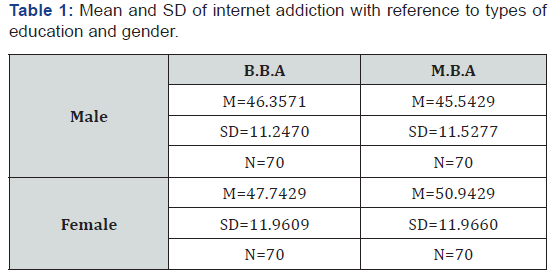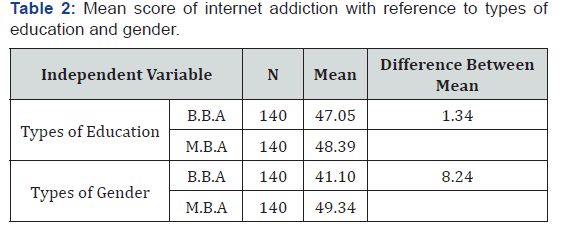A Psychological Study of Internet Addiction among Graduation and Post-Graduation Students
Chauhan Ajay J1*and R K Chocha2
1Department of Psychology, Saurashtra University Rajkot, India
2Department of Psychology, Shree G K and C K Bosamiya Arts and Commerce College Jetpur, India.
Submission: May 11, 2019; Published: June 20, 2019
*Corresponding author: Chauhan Ajay J, Ph.D. Research Scholar, Department of Psychology, Saurashtra University Rajkot, Gujarat, India
How to cite this article:Chauhan Ajay J, R K Chocha. A Psychological Study of Internet Addiction among Graduation and Post-Graduation Students. Psychol Behav Sci Int J. 2019; 12(2): 555833. DOI: 10.19080/PBSIJ.2019.12.555833
Abstract
The cardinal object of the present study was to investigate the Internet Addiction among Graduation and Post-Graduation students. The present study consisted sample of 280 students subjects (140 Graduation students and 140 Post Graduation students studying in Business administration), selected through random sampling technique from Bhavnagar city of Gujarat state. Data was collected with the help of Internet Addiction scale developed by Yung (1998), this scale was Gujarati Translated & developed by Detroja [1].
For data analysis and hypothesis testing Mean, SD, and ANOVA test was applied. Results revealed that there is a significant difference between internet addiction of male and female student. That result shows female student are more internet addict compare to male student. And there is no significant difference between Internet Addiction of BBA and MBA students. There is no significant interaction effect between Internet Addiction of types of education and gender.
Keywords: Internet Addiction, education, Graduation, Post-graduation, Bhavnagar, Addictive behaviours, Mental Disorder, Social anxiety, Psychological well-being, Personality Traits
Introduction
Researchers who study internet addiction in college students find that many students are faced with severe academic problems because they spend a significant amount of study time surfing irrelevant web sites, using social media, and playing interactive games on the Internet. These students had problems completing homework assignments, studying for exams or getting enough sleep to be alert for class the next morning due to late night Internet use. In one study, 50% of students interviewed after dismissal for academic failure listed excessive Internet usage as a reason for their problems. Internet is a global system that is increasingly used by all people as one of the most important devices for access of information in the world. The term ―Internet addiction was proposed by Dr. Ivan Goldberg in 1996 for pathological compulsive Internet use. Over the last couple of years, Internet addiction has been become a global concern to the public and can be classified as a health issue. There is even a proposal to include Internet addiction in the next revision of the Diagnostic and Statistical Manual of Mental Disorder. Addictive behaviours were suggested to cause improper life style and impairment to personalities, especially amongst the young. The education system has evolved and the use of technology is now encouraged at much younger ages. The use of the Internet on school campuses and in society has increased dramatically in recent years. Whereas the academic use of the Internet is primarily intended for learning and research, the Internet has also become an important part of student life. However, from time to time, cases of over involvement with the Internet have been observed on different campuses.
Review of Literature
The researcher conducts different research analysis blindly without keeping past studies. He thinks about that very novel whichever he by doing. The systematic along with rational study of related review is going to break his illusion and prevent the replication of work.
Prabha et al. [2] studied Present study main aim of Loneliness, Social Anxiety and Psychological Well-Being in Relation to Internet Addiction among Women College Students. The present study sample comprised of 285 Women college students from Chennai city. Study procedures included the administration of the following measures (i).Davis Online Cognition Scale (DOCS), Davis (2001), (ii). UCLA Loneliness Scale, Russell (1996), (iii). Social Anxiety Questionnaire (SAQ), Caballo, et al. (2012) and (iv). PGI General Well-being Measure, Verma &Verma (1974). The results of this study indicate that the Internet addiction in relation to Loneliness, Social anxiety and Psychological well-being were not found to be significant among women college students.
Chou & Hsiao [3] studied the present study sample in particular, 54 students was identified as Internet addicts. The present study developed a survey questionnaire with five parts. The first part, ``Chinese IRABI version II’’ (C-IRABI-II), after Brenner’s ``Internet- Related Addictive Behavior Inventory’’ (IRABI), Brenner (1996,1997) with some revised questions designed to fit Taiwan’s particular network environment. Unlike Brenner’s true/false questionnaire, this part contained 40 Likert-scale questions. The study also found that the most powerful predictor of Internet addiction is the communication pleasure score, followed by BBS use hours, sex, satisfaction score, and e-mail-use hours.
M Pandya et al. [4] finds out correlation between the youths’ Internet Addiction and Psychological well-being. They were selected 120 both males and females in equal numbers was selected through random sampling. Internet Addiction Inventory & Psychological well-being Inventory are tailor-made instruments, having sufficient reliability and validity. For the purpose of analysis, The Karl-Pearson ‘r’ technique was used.
Pandya M [5] finds out that no significant Negative correlation between the youths’ Internet Addiction and Personality Traits. The authors suggest that there is a need to explore the rural and the urban youths’ correlation in the line of above study. For this he selected sample were 120 both males and females in equal numbers was selected through random sampling. Internet Addiction Inventory & Personality Traits Inventory is tailor-made instruments, having sufficient reliability and validity.
Objectives
i. To study of internet addiction among graduation and post-graduation students.
ii. To study of internet addiction among male and female students.
iii. To study of interaction effect between internet addiction of types of education and gender.
Hypothesis
i. There is no significant difference between internet addiction of graduation and post-graduation students.
ii. There is no significant difference between internet addiction of male and female students.
iii. There is no significant interaction effect between internet addiction of types of education and gender.
Sample
The sample consisted of 280 computer science students. 140 of BBA students and 140 of MBA students. Out of which would be male students and would be female students selected as a sample. The sample was selected by random method from Bhavnagar city.
Procedure
Main aim of this study is to major the information about the graduation and post-graduation students. Internet addiction being other important variable types of education and gender. In this research 2 x 2 factorial design were used for the study variable like an internet addiction being of students reference of education and gender do they contained difference in which matter or not? It was be decided to take samples in equal numbers of generated variables under this research method of main and interactive.
Result and Discussion


The result according to 2 x 2 factorial design, mean & SD of types of education and gender with reference to internet addiction of the computer science students is present in Table 1. The result according to 2 x 2 factorial design, mean and difference of mean of internet addiction with reference to types of education and gender in present in Table 2. The result according 2 x 2 factorial design, ANOVA of types of education and gender with reference to computer science student is present in Table 3.
Table 3, ANOVA summary of internet addiction with reference to types of education and gender
To study about there is significant difference or not between internet addiction of under graduation and post-graduation students, null hypothesis no.1 was constructed
Conclusion
Hypothesis no 1 is that ‘There is no significant difference between internet addiction of graduation and post-graduation students.’ The F value of types of education Table 3 is 0.92. The present value is statistically not significant, also show the Table 3, the mean scores of Internet addiction of graduation and post-graduation students are 47.05 and 48.39 respectively and the difference between two is 1.34 which is also very negligible. Hence the null hypothesis No – 1 is maintained and it is conclude that there is no significant difference between internet addiction of graduation and post-graduation students. Study about there is significant difference or not between internet addiction of male and female students, null hypothesis No – 2 was constructed.
Hypothesis no 1. There is no significant difference between internet addiction of male and female. The F value of types of gender (Table 3) is 5.39. The present value is statistically significant of 0.05 level. When check the difference between the internet addiction of male and female students by F test, significant F value was found. Table 2 reveals that the mean scores of internet addiction of male and female students are 41.10 and 49.34 respectively and the difference between two is 8.24 which is high and not negligible. Hence the null hypothesis No – 3 is rejected and it is conclude that there is significant difference between the internet addiction of male and female students. The female students possess high internet addiction possess high internet addiction than difference can also be seen from graph No. 1 designed on the basis of obtained results [6].

Hypothesis no 2. There is no significant interaction effect between internet addiction of types of education and gender. The F value of interaction effect between types of education and Gender (Table 3) is 1.77 which is statistically not significant. To show the interaction effect of types of education and gender on internet addiction no significant impact found. Hence the null Hypothesis No. 3 was maintained, and it is conclude that there is no significant interaction effect of types of education and gender of internet addiction of the students.
References
-
- Detroja (2007) Internet addiction Inventory.
- Prabha, Sujaritha Magdalin (2016) Loneliness, Social Anxiety and Psychological Well-Being in Relation to Internet Addiction among Women College Students. International Journal of Indian Psychology 3(4): 63.
- Chou, Hsiao (2005) Internet addiction among some of the Taiwan's college students. Computers & Education 35: 65-80.
- Mohit M Pandya, Nitin R Korat (2015) Internet Addiction and Psychological Well-being among Youths of Rajkot District. International Journal of Indian Psychology 2(2).
- Mohit M Pandya (2015) Internet Addiction and Personality Traits among Youths of Rajkot District. International Journal of Indian Psychology 2(2).
- Zalawadia T (2017) Internet Addiction among Graduation and Post-graduation Students. The International Journal of Indian Psychology 4(1): 84.






























